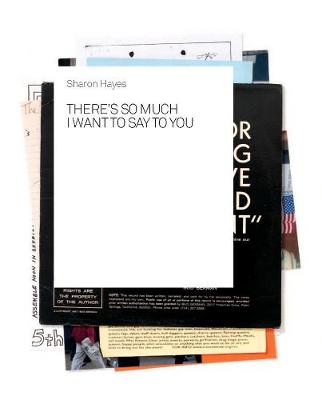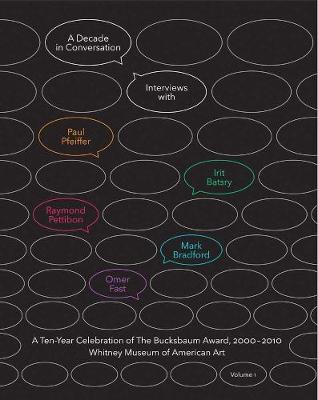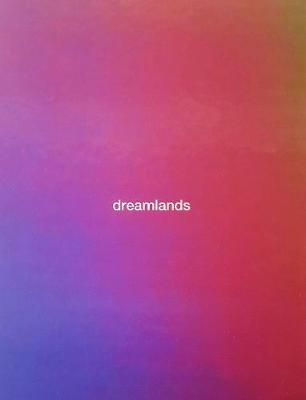Whitney Museum of American Art
4 total works
In her performances, videos, and installations, Sharon Hayes (b. 1970) explores the nexus between politics, history, speech, and desire. Her works modify or appropriate the language and tools of political dissent, creating unexpected affinities between important historical events and the present. Highlighted in this volume is the video installation Symbionese Liberation Army (SLA) Screeds #13, 16, 20 & 29 (2003)—a work in which Hayes memorized the famous taped speeches by Patty Hearst and her kidnappers, the leftist radical group the Symbionese Liberation Army, and then reads them to an audience who corrects her mistakes. It is in these slippages between memory and history that the meaning of Hayes's work resides. This book also includes a group of new site-specific works that addresses the Whitney's role in the historic development of process-based, performative art and its engagement with politics that took place in the late 1960s and early 1970s.
This book serves as document of Hayes’s thinking process, featuring original contributions from Hayes and some two-dozen other writers, artists, and activists, which provide insight into the motivations and development of her projects. The catalogue includes images carefully selected by the artist—photographs, vinyl LP covers, fliers, images of Hayes’s own work—and a short text response by each of the contributors. Contributors include: Dennis Adams, Lauren Berlant, Saramina Berman, Claire Bishop, Juli Carson, Kabir Carter, Christhian Diaz, Saeed Taji Farouky, Malik Gaines, Andrea Geyer, Leah Gilliam, Michela Griffo, Sharon Hayes, Holly Hughes, Chrissie Iles, Iman Issa, Hans Kuzmich, Cristobal Lehyt, Ralph Lemon, Brooke O’Harra, Jenni Olson, Dean Spade, Lynne Tillman, What, How & For Whom/WHW, Craig Willse.
Distributed for the Whitney Museum of American Art
Exhibition Schedule:
Whitney Museum of American Art(06/21/12–09/09/12)
This is the first publication to explore the role of mirrors, spinning, and “neurotic” architecture––a feeling of psychological breakdown––in the work of one of America’s most important contemporary artists, Paul McCarthy (b. 1945). The book is published in conjunction with a major exhibition at the Whitney, for which McCarthy is creating two new installations to appear alongside his Bang Bang Room (1992) and two recently rediscovered film loops (1966, 1971).
Each work involves a room structure that the viewer can step into and experience—often becoming disoriented as either the floor or entire structure spins, or as walls fold inward and outward. By comparing McCarthy’s use of rotational movement and visual effects to that of other artists of the 1960s and
1970s, the author seeks a new understanding of this bold innovator. An interview with McCarthy himself offers an unprecedented discussion of the influences on his art—including experimental filmmakers Stan Brakhage, Stan Vanderbeek, and Bruce Conner. The book not only raises new points but also recovers information and images from films once lost.Distributed for the Whitney Museum of American Art
Exhibition Schedule:
Whitney Museum of American Art (June 26 – October 12, 2008)
A Decade in Conversation: A Ten-Year Celebration of The Bucksbaum Award, 2000-2010
by Chrissie Iles, Christiane Paul, Carter E. Foster, and Tina Kukielski
Established in 2000 by the Martin Bucksbaum Family Foundation and the Whitney Museum of American Art, the Bucksbaum Award is presented biennially to an artist living and working in the U.S. “whose work demonstrates a singular combination of talent and imagination.”
A Decade in Conversation introduces each of the recipients—video artist Paul Pfeiffer, who often works with found footage; Irit Batsry, an artist specializing in video and installation pieces; Raymond Pettibon, whose acerbic and darkly satirical drawings critique contemporary culture; Mark Bradford, who specializes in abstract collage work and painting; and Omer Fast, known for exploring the possibilities of cinema. Featuring interviews with the artists and compelling illustrations and installation views, this book presents fascinating details about the ways the Bucksbaum award winners are shaping contemporary art today.
Distributed for the Whitney Museum of American Art
This generously illustrated publication surveys the work of filmmakers and artists who have pushed the material and conceptual boundaries of cinema. Over the past century, the material, optical, abstract, spatial, and tactile properties of film have been tested at a level of experimentation and utopian ambition that is generally unrecognized. Whether creating synesthetic or 3-D environments, projective or non-projective installations, generations of leading-edge artists have explored how technology transforms experience.
The essays published here offer an intensive look at the themes of cinematic space, formats of the screen, animation and CGI, the body and the cyborg, and the materiality of film. Contributors place particular emphasis on the idea of the cinema as a sensorium and on the ways in which it defines the human body, both through representation and in relation to the projected image. An immersive plate section brings together rarely seen and previously unpublished stills, in addition to concept drawings from historic and contemporary films.
Distributed for the Whitney Museum of American Art
Exhibition Schedule:
Whitney Museum of American Art, New York
(10/28/16–02/05/17)



